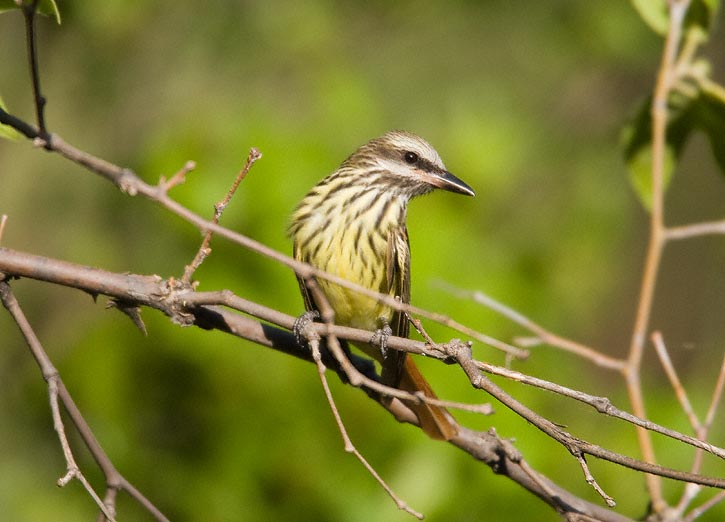
Myiodynastes luteiventris
SUBFAMILY
Tyranninae
TAXONOMY
Myiodynastes luteiventris Slater, P.L., 1859. Monotypic.
OTHER COMMON NAMES
French: Tyran tigrй German: Weisstirntyrann; Spanish: Benteveo
de Buche Amarillo.
PHYSICAL CHARACTERISTICS
8.5 in (21.5 cm). Like only one other tyrannid (the other is the
streaked flycatcher Myiodynastes maculatus), is streaked both
above and below. Plumage includes olive-green upperparts
with heavy streaking, pale yellow belly with dark brown streaking,
reddish rump and tail, whitish secondaries and wing
coverts, a blackish malar mark, and white stripes on face above
and below dark eye patch. Bill is thick and black. Yellow patch
in center of crown is visible only when crown is erect, during
passion or aggression while courting.
DISTRIBUTION
Southeastern Arizona to Costa Rica; winters from eastern
Ecuador to northern Bolivia.
HABITAT
Sycamore canyons, open woods, forest edges, and plantations.
BEHAVIOR
Lives singly or in pairs. Often perches high in canopy, remaining
hidden. Early-morning song is a soft, repeated “tree-le-reere!”
During courtship, both sexes sing a loud “kee-ZEE-ik!”
Migratory.
FEEDING ECOLOGY AND DIET
Spots prey from perch, hawks in midair, and typically returns
to perch to eat. Also gleans prey from foliage while hovering.
Takes large insects, caterpillars, and spiders, but will also eat
fruits and berries.
REPRODUCTIVE BIOLOGY
Male and female chase each other in flight during courtship.
Breeds monogamously, once per year, later in year than most
other flycatchers. Clutch of two to four eggs are incubated by
the female in a preformed cavity nest located in a tree knot,
abandoned nest, or bird box.
CONSERVATION STATUS
Not threatened.
SIGNIFICANCE TO HUMANS
None known.
Photo Gallery of - Sulphur-bellied flycatcher




 Animalia Life
Animalia Life